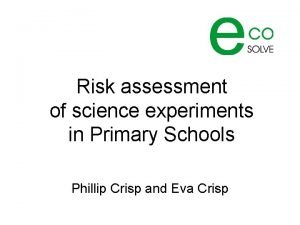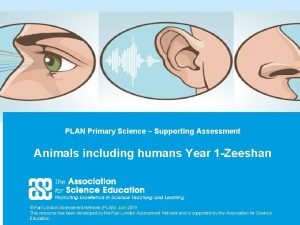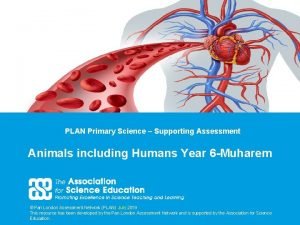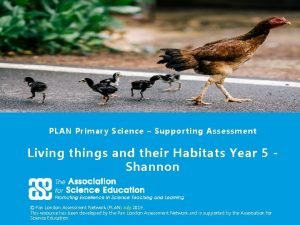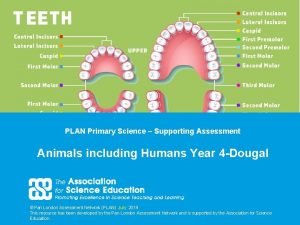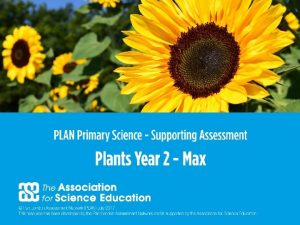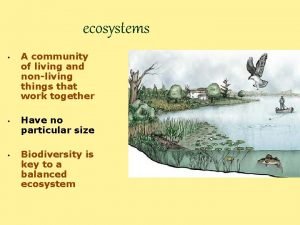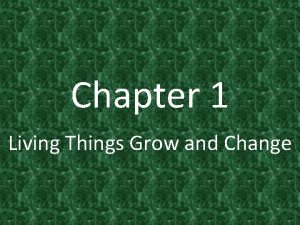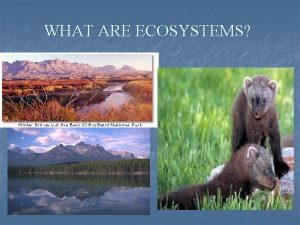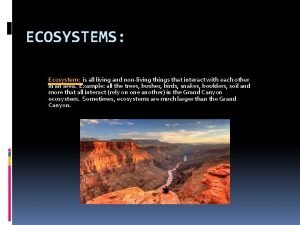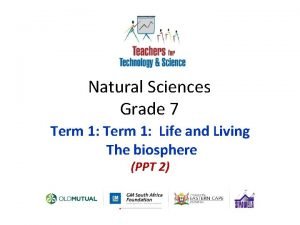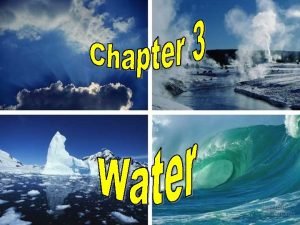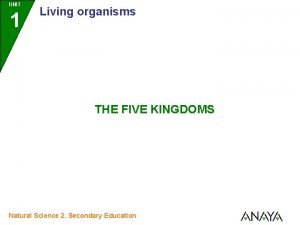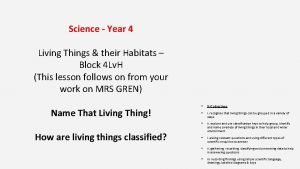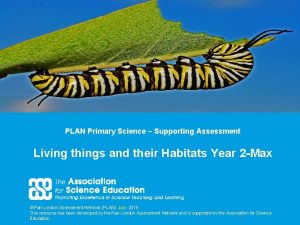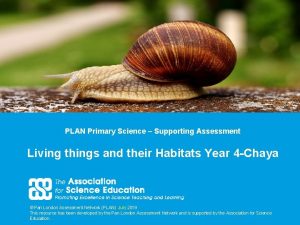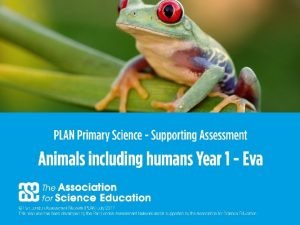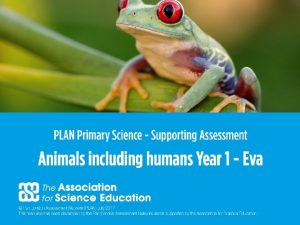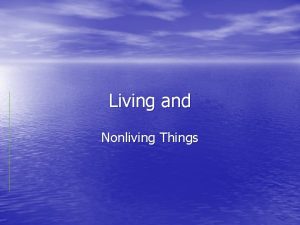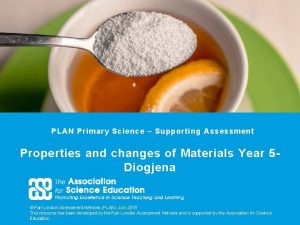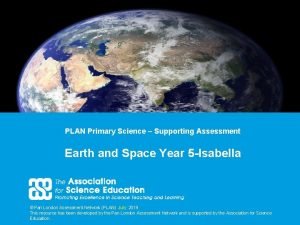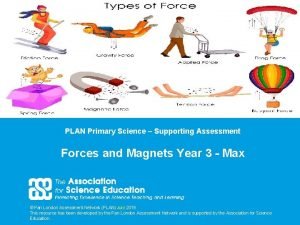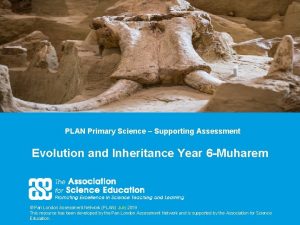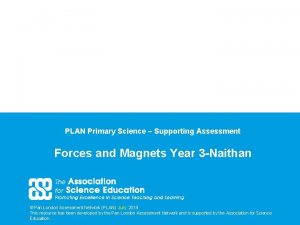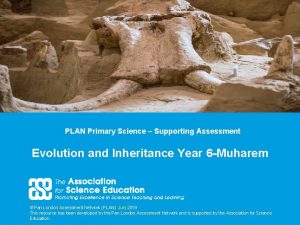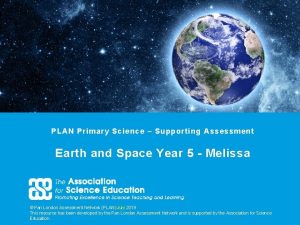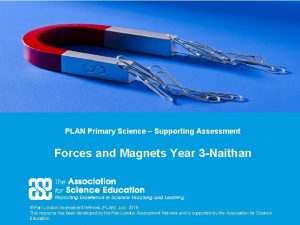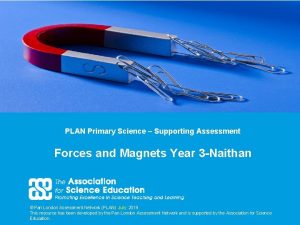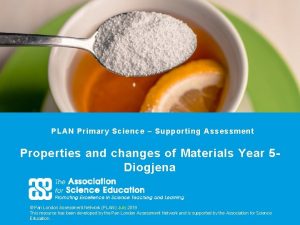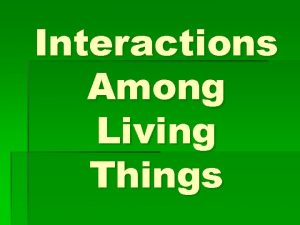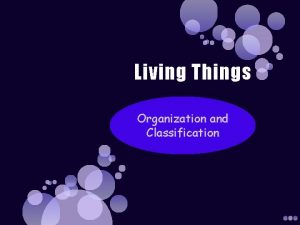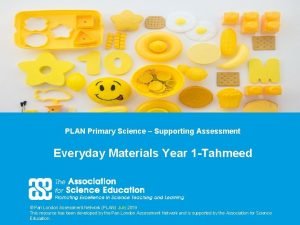PLAN Primary Science Supporting Assessment Living things and


























- Slides: 26

PLAN Primary Science – Supporting Assessment Living things and their Habitats Year 4 -Chaya © Pan London Assessment Network (PLAN) July 2019 This resource has been developed by the Pan London Assessment Network and is supported by the Association for Science Education. 1

PLAN Primary Science - Supporting Assessment PLAN Primary Science is a set of resources produced to enable teachers to have a clearer understanding of National Curriculum expectations for meeting the standard. Annotated collections of children’s work provide examples of what working at the expected standard for primary science might look like for the knowledge and conceptual understanding statements of the programmes of study (POS). It is not the intention of these resources to specifically exemplify the working scientifically statements. However, aspects of working scientifically have been shown as an integral part of the teaching and learning of the knowledge and concepts. The resources provided have been cross moderated multiple times before publishing so that they can be used with confidence by teachers and subject leaders. Each collection of work shows one example of how a pupil has met National Curriculum statements for a particular area of content but these are not intended to be the definitive way of teaching these statements. 2

Structure of the resources Each resource contains the relevant National Curriculum statements for the unit of work and prior learning, a planning matrix, annotated work and a summary sheet. The matrix provides an interpretation of the key learning of the National Curriculum statements, and suggestions of key vocabulary. In order to be meet the expectations pupils must firstly understand the key concept and then be provided with opportunities to apply that knowledge. This is a key planning tool. Key Learning Secure Possible Evidence Show Overview paragraph describing understanding of a curriculum concept by using scientific Key vocabulary – list of words vocabulary correctly Possible ways to demonstrate key learning, particularly correct usage of vocabulary Apply knowledge in familiar related contexts Possible ways to demonstrate that a pupil has gone beyond recall of facts and can apply the key learning, for example using the vocabulary and basic principles to produce explanations, usually within Working Scientifically contexts. Suggestions of contexts to use. 3

Contents of the materials Please note: The NC statements for each topic area for the relevant year group are stated on the slide. Only the statements in bold on that slide have been exemplified. In these cases the teachers have chosen to split the statements within the topic area to teach at different times. The prior NC statements relevant to the topic area are also stated and use to determine pupils’ knowledge at the start of the unit. Each slide has been annotated with coloured text. Please see key below: Red Commentary to explain how evidence meets/does not meet NC statements Blue Commentary to highlight features of working scientifically Green Pupil Speak Grey Other relevant information eg. vocabulary used 4

Prior Learning Y 1 Statements Prior Learning Year 1 statements Pupils should be taught to: • identify and name a variety of common wild and garden plants, including deciduous and evergreen trees (1 -Plants) • identify and describe the basic structure of a variety of common flowering plants, including trees (1 -Plants) • identify and name a variety of common animals including fish, amphibians, reptiles, birds and mammals (1 -Animals, including Humans) • describe and compare the structure of a variety of common animals (fish, amphibians, reptiles, birds and mammals, including pets) (1 -Animals, including Humans) 5

Prior Learning Y 2 Statements Prior Learning Year 2 statements Pupils should be taught to: • identify and name a variety of plants and animals in their habitats, including microhabitats (2 -Living things and their Habitats) 6

Prior Learning Y 3 Statements Prior Learning Year 3 statements Pupils should be taught to: • identify and describe the functions of different parts of flowering plants: roots, stem/trunk, leaves and flowers (3 -Plants) 7

Year. Y 44 Statements statements Pupils should be taught to: • recognise that living things can be grouped in a variety of ways (4 -Living things and their Habitats) • explore and use classification keys to help group, identify and name a variety of living things in their local and wider environment (4 -Living things and their Habitats) • recognise that environments can change and that this can sometimes pose dangers to living things (4 -Living things and their Habitats) 8

Later Statements Pupils do not need to be taught content they will learn in later year groups. They can be challenged by applying the content for their year group in broader contexts. Pupils in Year 5 will be taught to: • describe the differences in the life cycles of a mammal, an amphibian, an insect and a bird. (5 -Living things and their Habitats) • describe the life process of reproduction in some plants and animals. (5 Living things and their Habitats) Pupils in Year 6 will be taught to: • describe how living things are classified into broad groups according to common observable characteristics and based on similarities and differences, including micro-organisms, plants and animals. (6 -Living things and their Habitats) • give reasons for classifying plants and animals based on specific

Assessment guidance Key learning Possible Evidence Shows understanding of a concept using scientific vocabulary correctly Living things can be grouped (classified) in different ways according to their features. Classification keys can be used to identify and name living things. Can name living things living in a range of habitats, giving the key features that helped them to identify them Can give examples of how an environment may change both naturally and due to human impact SECURE Living things live in a habitat which provides an environment to which they are suited (year 2 learning). These environments may change naturally e. g. through flooding, fire, earthquakes etc. Humans also cause the environment to change. This can be in a good way i. e. positive human impact, such as setting up nature reserves or in a bad way i. e. negative human impact, such as littering. These environments also change with the seasons; different living things can be found in a habitat at different times of the year Key vocabulary Classification, classification keys, environment, habitat, human impact, positive, negative, migrate, hibernate Applying knowledge in familiar Observe plants and animals in different habitats throughout the year related contexts, including a range of Compare and contrast the living things observed enquiries Use classification keys to name unknown living things Classify living things found in different habitats based on their features Create a simple identification key based on observable features Use fieldwork to explore human impact on the local environment e. g. litter, tree planting Use secondary sources to find out about how environments may naturally change Use secondary sources to find out about human impact, both positive and negative, on environments Can keep a careful record of living things found in different habitats throughout the year (diagrams, tally charts etc. ) Can use classification keys to identify unknown plants and animals Can present their learning about changes to the environment in different ways e. g. campaign video, persuasive letter

Initial activity to engage prior learning • identify and name a variety of common animals including fish, amphibians, reptiles, birds and mammals • describe and compare the structure of a variety of common animals (fish, amphibians, reptiles, birds and mammals, including pets) The children were shown images of three animals and asked to discuss which one they thought was the odd one out giving a reason. The giraffe could be the odd one out as it has horns and a long neck compared to its body. The frog is the only one that you can’t see ears. The rabbit is the only one with a fluffy tail. Chaya describes and compares the structure of the animals and shows that she is secure on this prior learning in year 2. 11

Initial activity to engage prior learning • recognise that living things can be grouped in a variety of ways • explore and use classification keys to help group, identify and name a variety of living things in their local and wider environment • recognise that environments can change and that this can sometimes pose dangers to living things Classification is when you sort things into groups. I don’t know what a classification key looks like though. Chaya shows an awareness that a habitat is where an animal lives. At this point she is not considering the plants that also live in the habitat even though the stimulus images provided do include plants. She does not demonstrate any evidence that she understands the impact that humans can have on a habitat. 12

Exploring a local habitat (consolidation of year 2 statements) • identify and name a variety of plants and animals in their habitats, including micro-habitats The children were taken out to investigate a habitat. They were told to look for living things in the habitat they could identify and name. They then drew and labelled these. The worm and the slug were under the log. The ant, the daffodil and the moss were in the grass. The bird was in the tree. Chaya identifies and names a variety of plants and animals and talks about where she found them. 13

Classification in different ways • recognise that living things can be grouped in a variety of ways • explore and use classification keys to help group, identify and name a variety of living things in their local and wider environment The teacher modelled how to sort into a single criteria. The children were then given images and hoops to practice this in small groups choosing different criteria and then recording one of their sorts in their books. Chaya’s group also sorted by fur, feathers, visible ears, legs and wings. This process was then repeated modelling how to choose two criteria to create an intersecting Venn diagram. Chaya groups living things in a variety of ways. 14

Creating classification keys • recognise that living things can be grouped in a variety of ways • explore and use classification keys to help group, identify and name a variety of living things in their local and wider environment In small groups the children used the pictures to play ‘Guess who’, asking questions that could only be answered yes or no to identify which animal had been chosen. Does it have legs? Does it lay eggs? Does it fly? Do the eggs have a hard shell? Chaya asks a range of questions to help her identify the animal. Using a visualiser the teacher showed the children how to use straws and post it notes to create a classification key for different animals. They then practiced this in groups. 15

Creating classification keys (contd. ) • recognise that living things can be grouped in a variety of ways • explore and use classification keys to help group, identify and name a variety of living things in their local and wider environment The children then chose four of the animals and created a classification key independently. Chaya then completed a second key with five animals. Chaya creates classification keys to help group animals. 16

Creating classification keys (contd. ) • recognise that living things can be grouped in a variety of ways • explore and use classification keys to help group, identify and name a variety of living things in their local and wider environment To ensure the children were secure with creating classification keys the teacher asked them to approach the task in a different way by placing the animals at the bottom and then working up the key identifying suitable questions to separate the animals. Many of the children found this approach easier. Chaya asks suitable questions based on her knowledge of the animals to complete the classification key. 17

Identifying and naming leaves • recognise that living things can be grouped in a variety of ways • explore and use classification keys to help group, identify and name a variety of living things in their local and wider environment The teacher became aware that the focus had predominantly been on classifying animals. To address this a trip was planned to the local park to use classification keys to identify and name trees. The teacher gathered leaves from the park for the children to look at prior to their visit. They were given the Nature Detective Leaf ID sheet to identity and name their leaves This one is holly as it is the same shape and has spikes. This leaf is the horse chestnut as it has five leaves all coming from one point. This one is oak because it has a curvy edge. Chaya matches leaves to those on the sheet in order to be able to name them.

Odd one out • recognise that living things can be grouped in a variety of ways • explore and use classification keys to help group, identify and name a variety of living things in their local and wider environment After they had identified and named their leaves they were asked to choose three and talk about which might be the odd one out. The holly leafy is the only one that is shiny. It also has spikey edges. The elder has five leaves on one stem. The alder is more round in shape Chaya identifies features that can be used to sort leaves. 19

Creating a leaf classification key • recognise that living things can be grouped in a variety of ways • explore and use classification keys to help group, identify and name a variety of living things in their local and wider environment Does it have many leaves on one stem? Y N Does it have only 5 leaves on its stem? Does it have a tear drop shape? Y The children worked in pairs using ICT to create a classification key for the leaves they had been given. They then removed the images and replaced these with the name so that another group could check the key worked. N N Does it have lobed edges ? N Y N Does it have ridged edges? Y Does it have a tear drop leaf with a pointed top? Y N Y Does it have spikey edges? Y N Chaya suggests suitable questions to separate the leaves in order to create the key and was able to use another pair’s key to check it worked. 20

Using the leaf classification key • recognise that living things can be grouped in a variety of ways • explore and use classification keys to help group, identify and name a variety of living things in their local and wider environment Later in the week when the children went on the trip to the local park they took their tree keys with them and used them to identify and name the trees that they found The leaves on this tree have more than one leaf on the stem. There are more than 5. It has ridged edges so it must be the rowan. Chaya uses the key she created to help her to name the trees. I know that is holly as the leaves are spikey. 21

Using a butterfly classification key • recognise that living things can be grouped in a variety of ways • explore and use classification keys to help group, identify and name a variety of living things in their local and wider environment The children were also given a butterfly classification key in case they saw any butterflies when they were out. We saw the yellow one. I used the key and it is called brimstone. We also saw a reddy coloured one. I think it was a comma but it was difficult to see the edges of its wings. Chaya is secure in using classification keys to identify and name living things. 22

Writing to Greenpeace • recognise that environments can change and that this can sometimes pose dangers to living things The children watched a BBC newsround clip about the weedy sea dragon. They then wrote a letter to Greenpeace from the perspective of the weedy sea dragon. This writing shows a good understanding of the link between human action and the impact this has on living things. 23

Assembly about environmental issues • recognise that environments can change and that this can sometimes pose dangers to living things In preparation for an assembly about conservation the children were asked to research an environmental issue. They were first given some images to look at and they talked about what might be the issue. The cars are polluting the air so that people have to wear masks. People have left rubbish on the beach. This may harm the animals in the sea. Chopping down trees is bad as they give us oxygen. They are also homes for animals. Chaya shows awareness of environmental issues and the impact of these on living things. The children then researched the causes, impact and possible solutions to one issue and presented their findings during their assembly. Chaya independently researched and presented the causes, impact and possible solutions of 24 deforestation.

Overall Summary Overall summary – secure Chaya talks about the similarities and differences between examples of plants and animals. She is able to use these to group living things in a variety of ways. She has successfully used keys to identify and name living things in her local and wider environment. She asks appropriate questions in order to group living things and to create keys. She recognises that environments can change and that this can sometimes pose danger to living things (the weedy sea dragon). She shows an understanding that human actions can impact on the environment and can suggest some solutions to the issues. . 25

Acknowledgements Slide 17 Nature Detective Leaf ID Slide 21 images from Nature Detective Butterfly ID 26
 Whats an energy pyramid
Whats an energy pyramid The smallest living unit of all living things is
The smallest living unit of all living things is What are the seven life processes of living things
What are the seven life processes of living things Risk assessment for science experiments
Risk assessment for science experiments Fixation omission emphasis
Fixation omission emphasis Primary and supporting instruments ifr
Primary and supporting instruments ifr Plan primary science
Plan primary science Plan primary science
Plan primary science Plan primary science
Plan primary science Plan primary science
Plan primary science Plan primary science
Plan primary science What are your favorite subjects?
What are your favorite subjects? Ecosystem living and nonliving things
Ecosystem living and nonliving things What is a community of living and nonliving things
What is a community of living and nonliving things Things that have roots
Things that have roots Unicellular vs multicellular activity
Unicellular vs multicellular activity Things that grow and change
Things that grow and change Non living things in temperate forest
Non living things in temperate forest Things in ecosystem
Things in ecosystem Is moss living or non-living
Is moss living or non-living Living non living dead
Living non living dead Biosphere grade 7
Biosphere grade 7 Why is water important to living things
Why is water important to living things Five kingdoms science
Five kingdoms science Living things grow
Living things grow Living things meaning
Living things meaning Is hagfish slime a lipid
Is hagfish slime a lipid



